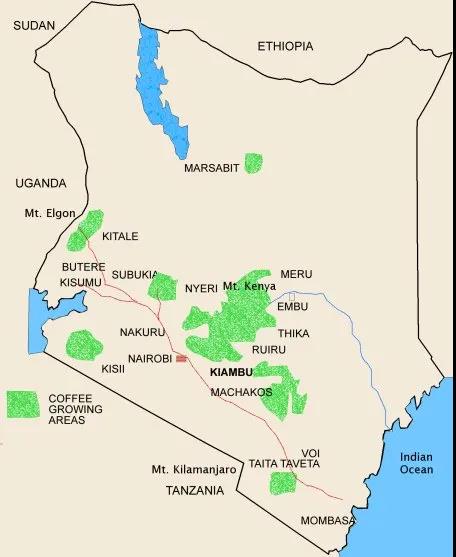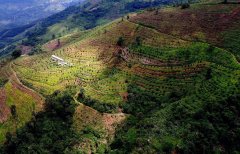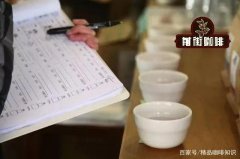The origin of coffee-where does Kenyan coffee come from, how is it graded, is Kenyan coffee good?
The Republic of Kenya (The Republic of Kenya) is located in eastern Africa, the equator runs through the central part, and the Great Rift Valley of East Africa runs through the north and south. It is bordered by Somalia to the east, Tanzania to the south, Uganda to the west, Ethiopia and South Sudan to the north, and the Indian Ocean to the southeast. The coastline is 536 km long. 18% of the land area is arable land, and the rest is mainly suitable for animal husbandry.
Most Kenyan coffee grows at an altitude of 1500m, 2100m above sea level, and is harvested twice a year. Its main feature is a distinct fruit aroma, the common fruit aroma is citrus. Kenyan coffee has a multi-layered taste and juice acidity, perfect grapefruit and wine flavor, moderate mellow, is the favorite of many people in the coffee industry. Kenyan Coffee became more famous with the sensation of the Hollywood movie OutofAfrica.
It entered Kenya in the 19th century, when Ethiopian coffee drinks were imported into Kenya through southern Yemen. But it was not until the early 20th century that the bourbon was introduced by the St. Austen Mission (St.AustinMission).
Kenyan coffee is mostly grown at an altitude of 1500m, 2100m, and is harvested twice a year. To ensure that only ripe berries are picked, people must tour the forest about seven times. Kenyan coffee is grown by small farmers. After they harvest the coffee, they first send the fresh coffee beans to the cooperative cleaning station. The washing station sends the dried coffee to the cooperative in the form of "parchment coffee beans" (that is, coffee beans covered with endocarp) to the cooperative ("parchment coffee beans" is the last state of coffee beans before peeling). All the coffee is collected together, and the growers charge the average price according to their actual quality. This trading method generally works well and is fair to both growers and consumers.

In 1930, commissioned by the Kenyan government, a Scott Labs laboratory was set up with the task of selecting varieties suitable for planting in Kenya, with high yield and good disease resistance. After 42 breeding were numbered and screened one by one, SL-28 and SL-34 were finally obtained, the former originated from bourbon and SL-34 from iron pickup, they are not a series of varieties. These two varieties, which currently account for 90% of Kenya's production, have become generally recognized representatives of Kenyan coffee varieties, and South America is also actively introducing SL28 as a planting variety.
Although the two varieties are different, they are strikingly similar in flavor, with complex acidity and great sweetness. But according to Qianjie, in the later development, SL28 is better in adaptability and flavor. SL28 has blackcurrant-like acidity, sweetness, balance and complex flavor, as well as remarkable citrus and black plum characteristics. On the other hand, SL-34 has a bright fruit flavor and a soft and clean taste. One of the Kenyan coffee beans in Qianjie Coffee, which comes from Sassini Manor, contains not only SL-28 and SL-34, but also a special variety called Ruiru 11.
Ruiru 11 is a hybrid variety developed by the Kenyan government under the background of the global outbreak of iron rust, but its flavor quality is far lower than that of the previous sl28 sl34 and has not been developed in the boutique coffee industry. However, many imported specialty coffee suppliers will mix these hybrid beans with Blend to reduce costs.
3. Kenya (graded by particle size)
Kenya coffee beans are graded mainly according to the size of coffee particles, usually divided into eight grades.

E (elephant bean): the "E" here stands for Elephant, that is, "elephant", but it is not the elephant bean in the coffee bean variety (Maragogype). It is a kind of bean whose two seeds are intertwined with each other because of abnormal development, forming a "seemingly one" bean, which can be regarded as a flaw. Generally speaking, there are two seeds in a fruit, affixed face to face, so there will be a flat side, called flat beans, mother beans. E-grade beans are beans in which two seeds stick together and become super-large in the process of growth. aah! aah! The size of E-grade bean particles is more than 18 mesh (1 mesh is 1 to 64 inches), and the number is rare.
AA: the size of this grade is about 17018 items (about 6.7~7.1mm), which is the Kenyan coffee grade that most people often hear. In boutique coffee, this grade is usually called AA TOP, and it is also a bean that most coffee shops will sell. But AA does not represent the best, it is just that the size of beans should not be confused with flavor.
AB: most coffee beans are in this category. The main reason why they are called AB is that A with a mesh size of 6.80 mm,B is 6.20mm, and these two sizes of coffee beans (An and B) are sold together, so they are called AB, with a size of about 15 million 16 mesh (about 6.0~6.4mm).
C: the particle size falls between 14015 mesh (about 5.6~6.0mm), which is smaller than that of B grade.
PB: the full name is Peaberry, also known as small round beans, can also be called public beans. Compared with ordinary flat beans, this is also rare, accounting for about 10% of all coffee beans, mainly because only one seed in the fruit has developed to get small and round beans. Some people will particularly like the flavor of PB, so they will pick out the PB and sell it.
TT: these coffee beans are light beans selected from AA and AB beans by air sorter. They are usually light in weight and substandard in hardness, as well as broken and defective beans.
T: lighter beans, broken beans, and even broken fragments of beans selected from C-grade beans.
MH/ML: this kind of coffee beans will not be exported. They are usually coffee beans that are overripe and fall to the ground. They are of poor quality, accounting for about 7% of all coffee beans, only for the Kenyan domestic market.

Important Notice :
前街咖啡 FrontStreet Coffee has moved to new addredd:
FrontStreet Coffee Address: 315,Donghua East Road,GuangZhou
Tel:020 38364473
- Prev

How to plant a coffee tree? The natural conditions of coffee cultivation and the skills of growing coffee.
How to grow coffee well? First of all, geographically, the golden planting belt of coffee is centered on the equator, covering the appropriate temperature from 25 north latitude to 25 south latitude. Coffee likes a warm environment, hardy but not hardy, and the most suitable planting temperature is between 16 degrees Celsius and 21 degrees Celsius. Good land environment, fertile soil. The most suitable soil for growing coffee is in the plains and mountains.
- Next

Cup test coffee is what kind of process, cup test coffee meter, cup test how to score?
Cup test coffee is what kind of process, cup test coffee meter, cup test how to score? The items tested in the COE cup are: aroma, cleanliness, sweetness, acidity, oral touch, flavor, aftertaste, balance, overall. COE is the abbreviation of Cup Of Excellence, which translates to the Cup of Excellence. The Excellence Cup Program was born in 1999. The main goal of the project is: through the quality coffee competition.
Related
- Detailed explanation of Jadeite planting Land in Panamanian Jadeite Manor introduction to the grading system of Jadeite competitive bidding, Red bid, Green bid and Rose Summer
- Story of Coffee planting in Brenka region of Costa Rica Stonehenge Manor anaerobic heavy honey treatment of flavor mouth
- What's on the barrel of Blue Mountain Coffee beans?
- Can American coffee also pull flowers? How to use hot American style to pull out a good-looking pattern?
- Can you make a cold extract with coffee beans? What is the right proportion for cold-extracted coffee formula?
- Indonesian PWN Gold Mandrine Coffee Origin Features Flavor How to Chong? Mandolin coffee is American.
- A brief introduction to the flavor characteristics of Brazilian yellow bourbon coffee beans
- What is the effect of different water quality on the flavor of cold-extracted coffee? What kind of water is best for brewing coffee?
- Why do you think of Rose Summer whenever you mention Panamanian coffee?
- Introduction to the characteristics of authentic blue mountain coffee bean producing areas? What is the CIB Coffee Authority in Jamaica?

